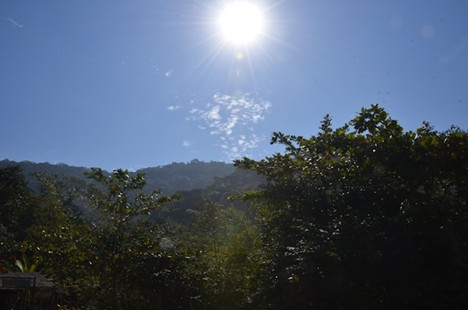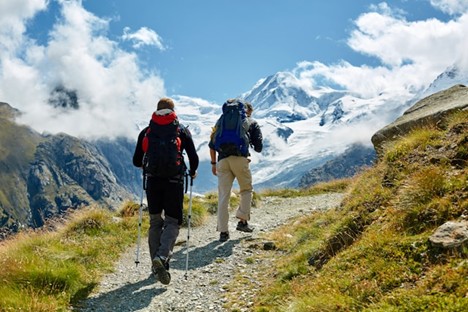
As winter melts into summer, many skiers and snowboarders swap their gear for hiking boots, climbing ropes, or mountain bikes. But even though the snow is gone, the risks associated with high-altitude environments remain - especially when it comes to sun exposure. In fact, UV intensity increases with elevation, making sun protection even more critical during summer adventures in the mountains.
The same peaks that offer stunning vistas and thrilling activities also pose a significant risk to your skin and eyes if you're not prepared. Many outdoor enthusiasts stop by their local snowboard shop this time of year to pick up high-performance sunglasses, UPF-rated clothing, and other essentials for high-altitude protection. In this article, we’ll break down everything you need to know to guard against sun damage - whether you're tackling a Colorado 14er, exploring alpine trails on your bike, or enjoying a scenic hike in former ski terrain.
Most people associate strong UV rays with tropical beaches or desert heat—but high-altitude environments actually pose a much greater risk. According to the World Health Organization, UV radiation increases by approximately 10–12% for every 1,000 meters (about 3,280 feet) in elevation. At elevations common in Colorado and other mountainous regions, this means you could be exposed to 25–50% more UV radiation than at sea level.
Compounding the problem, cool temperatures at elevation can mask the intensity of the sun. You might not feel hot, but the UV damage is still happening. Snowfields, water, and light-colored rock surfaces can also reflect UV rays, doubling your exposure without you even realizing it.
If you’re a skier used to winter sun protection, your instincts are in the right place—but summer requires an adapted approach. Less clothing, higher UV intensity, and longer exposure times all make summer protection critical.
One of the most overlooked aspects of sun protection is eye care. High UV exposure can lead to conditions such as photokeratitis (essentially a sunburn of the cornea), cataracts, and long-term damage to retinal tissue.
What to Look For in Sunglasses:
UV Protection: Make sure your sunglasses offer 100% UVA and UVB protection. This is non-negotiable.
Wraparound Design: Glasses that fit closely and curve around your face help prevent light from entering at the sides, especially during snowfield crossings or water activities.
Polarization: While not directly related to UV, polarized lenses reduce glare from reflective surfaces like water, snow, and rocks—offering clearer vision and reducing eye strain.
Lens Color: Gray, brown, or green lenses work well for most mountain activities. Consider interchangeable lenses if you’re tackling a range of light conditions.
Fit and Durability: Look for frames that stay in place when you’re sweating or moving quickly. Rubberized nose pieces or temples can help.
Bonus tip: Carry a hard case in your pack. You’ll want to protect your investment when you’re stashing them during cloud cover or in shaded areas.
Sunscreen is your first line of defense when clothing can’t cover everything—think nose, ears, neck, and hands. But not all sunscreens are created equal, and proper application matters more than you think.
Choose Wisely:
Broad Spectrum: This protects against both UVA (aging) and UVB (burning) rays.
SPF 30 or higher: SPF 30 blocks about 97% of UVB rays; higher SPFs offer slightly more protection but no sunscreen blocks 100%.
Water- and Sweat-Resistant: Vital for outdoor activity. Reapply every 2 hours—or more frequently if sweating heavily or wiping your face.
Mineral vs. Chemical: Mineral sunscreens (zinc oxide or titanium dioxide) sit on top of the skin and are less likely to cause irritation. They also start working immediately, while chemical sunscreens need about 20 minutes to activate.
Application Tips:
Don't Skimp: Most people only apply 25–50% of the recommended amount. You need about a shot glass (1 oz) to fully cover your body.
Don't Miss These Spots: Ears, underside of chin and nose, back of neck, hands, and tops of feet.
Layer It: If you’re using insect repellent or moisturizers, apply sunscreen first.
Use Lip Balm with SPF: Your lips are just as susceptible to sun damage.

UPF stands for Ultraviolet Protection Factor, and UPF-rated clothing is one of the most effective ways to protect your skin—especially when you're sweating or on multi-hour adventures. Unlike sunscreen, it doesn’t wear off or need reapplication.
Key Features to Look For:
UPF 50+ Rating: This means the fabric blocks 98% of UV rays.
Moisture-Wicking and Breathable: Modern UPF clothing is designed for athletic performance.
Coverage: Long sleeves, collars, and hoods provide more protection. Look for extended cuffs with thumbholes for hand protection.
Versatility: Convertible pants, zip-off sleeves, and lightweight packable designs make UPF clothing adaptable to changing conditions.
Color and Fabric: Darker colors and tighter weaves offer better protection than light, loose fabrics. However, many UPF garments are specifically engineered to provide maximum sun protection in light tones as well.
Popular Choices for Summer Skiers:
Even with the best gear, smart behavior can make a big difference.
Time Your Adventures: Aim for early morning or late afternoon activity to avoid peak UV hours (10 AM–4 PM).
Take Shade Breaks: Use trees, rock overhangs, or even your backpack to create shade during rest stops.
Hydrate Often: Dehydration can increase skin sensitivity and your body’s inability to cool itself.
Check UV Index Reports: Weather apps often include a UV rating—plan accordingly on high-index days.
Sunburn isn’t just a temporary discomfort. Repeated UV exposure increases your risk of skin cancer, accelerates aging, and can lead to serious eye conditions. Skiers are already more sun-aware than many outdoor athletes, but summer often tempts even the most diligent among us to let our guard down.
By combining physical barriers like sunglasses and UPF clothing with smart sunscreen practices and sun-conscious habits, you can significantly reduce your lifetime UV exposure while still enjoying every moment in the mountains.
As you trade winter gear for summer trail essentials, take your sun protection as seriously as your avalanche beacon or helmet. After all, mountain environments may look inviting and serene, but they’re also home to some of the most intense solar radiation you’ll face all year.
So, next time you lace up your hiking boots or pump your bike tires for a Colorado high-country ride, ask yourself: am I prepared for the sun as much as the summit?
Your future self-wrinkle-free and sunburn-free self will thank you.